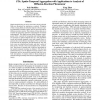Free Online Productivity Tools
i2Speak
i2Symbol
i2OCR
iTex2Img
iWeb2Print
iWeb2Shot
i2Type
iPdf2Split
iPdf2Merge
i2Bopomofo
i2Arabic
i2Style
i2Image
i2PDF
iLatex2Rtf
Sci2ools
AAAI
2000
2000
STA: Spatio-Temporal Aggregation with Applications to Analysis of Diffusion-Reaction Phenomena
Spatio-temporal data sets arise when time-varying physical fields are discretized for simulation or analysis. Examples of time-varying fields are isothermal regions in the sea or pattern formations in natural systems, such as convection rolls or diffusion-reaction systems. The analysis of these data sets is essential for generating qualitative interpretations for human understanding. This paper presents Spatio-Temporal Aggregation (STA), a system for recognizing and tracking qualitative structures in spatio-temporal data sets. STA algorithms record and maintain temporal events and compile event sequences into concise history descriptions. This is carried out at several levels of description, from the bottom up: first, low level events are identified and tracked, and then a subset of those events, relevant at the next description level, is identified. The process is iterated until a high level description of the system's temporal evolution is obtained. STA has been demonstrated on...
AAAI 2000 | Diffusion-reaction Systems | Intelligent Agents | Spatio-temporal Data Sets | Time-varying Physical Fields |
| Added | 01 Nov 2010 |
| Updated | 01 Nov 2010 |
| Type | Conference |
| Year | 2000 |
| Where | AAAI |
| Authors | Iván Ordóñez, Feng Zhao |
Comments (0)

